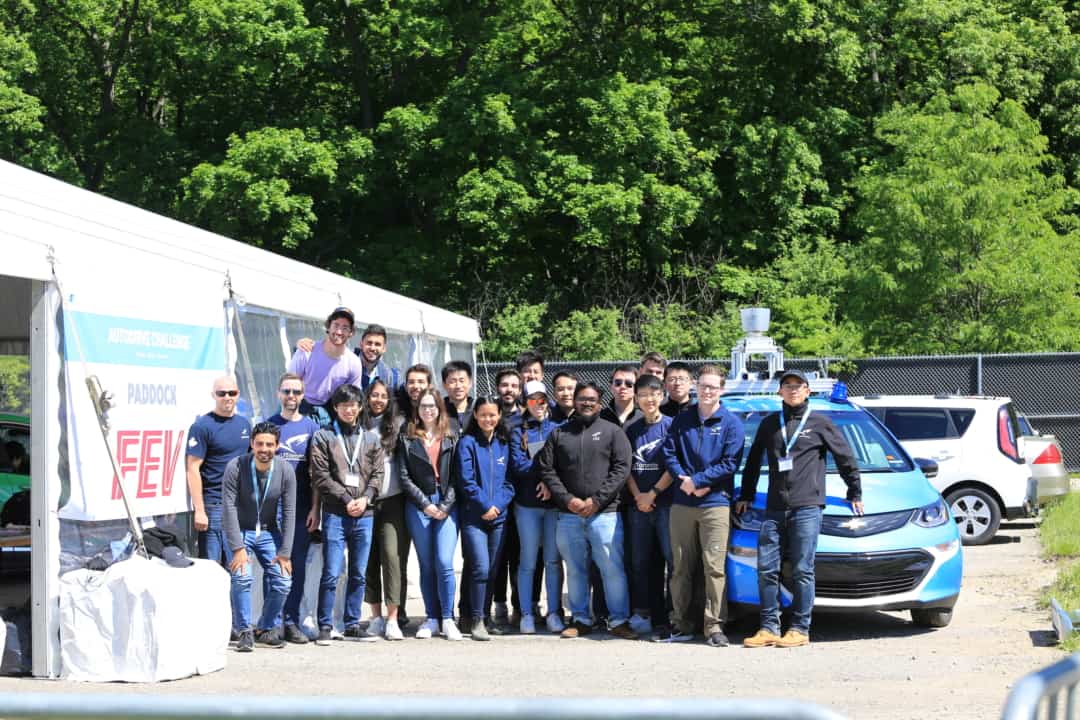This victory marks the second consecutive year that the team has won first place in the AutoDrive Challenge, as it did last year against the same competitors. The competition, run by the Society of Automotive Engineers (SAE) International and General Motors, will hold its final round for this three-year cycle in 2020.
The team scored first in eight categories
aUToronto won first place in eight of nine categories this year, defeating competitors from the University of Waterloo, Michigan State University, Michigan Tech University, Kettering University, Virginia Tech, North Carolina A&T State University, and Texas A&M University.
For its ability to recognize traffic signs, such as speed limits and ‘do not enter’ signs, as well as respond appropriately to them, aUToronto’s Zeus won first place in the Traffic Control Sign Challenge.
aUToronto’s car also placed first in the Pedestrian Challenge, which tested cars on their ability to wait for pedestrian replicas to completely cross a road before proceeding, as well as in the MCity Challenge, which required the vehicles to navigate around obstacles such as a tunnel and railroad crossing.
“Correctly detecting and classifying all the traffic lights and signs was more difficult than we anticipated,” reflected aUToronto Team Lead Keenan Burnett in an email to The Varsity.
The team’s approach to the problem, which utilized deep neural networks, or systems of artificial neurons, required substantial tuning and data collection to work effectively.
Zeus further secured first place in the Intersection Challenge and tied for first in the Mapping Challenge.
One key aspect to the team’s success here can be attributed to the realization that “relying only on GPS/IMU for positioning [could have been] risky.”
“We opted to integrate a more advanced localization software that uses [a laser system called] LIDAR instead,” wrote Burnett. “This proved to be one [of] the keys to our success at the competition.”
aUToronto also scored first in the categories of Social Responsibility Report, Social Responsibility Presentation, and Concept Design Presentation. The team placed second in Concept Design.
Origins of aUToronto and Zeus
“The team’s inception traces back to when SAE was soliciting applications from universities to compete in their new self-driving competition,” wrote Burnett.
“The idea is that they would select the [eight] top university applications based on the quality of the proposals, the backing of the university, and facilities that would be made available to students.”
Cristina Amon, U of T’s Dean of Engineering at the time, requested Professor Tim Barfoot to submit a proposal in 2017, according to Burnett. Professors Barfoot and Angela Schoellig, from the U of T Institute for Aerospace Studies (UTIAS), partnered to submit the proposal and were selected as one of the eight competing university teams.
Burnett, who was then applying to be a graduate student at UTIAS, asked Barfoot if a position was available to run the team. He was hired after an interview in April.
“From then, I built the year 1 team up from scratch,” wrote Burnett. “We hired a small set of students with excellent technical and leadership skills to head the sub-teams for the first year of the competition.”
Burnett then let the sub-team leads hire their own sub-team members. New members have been recruited roughly every four months since the fall of 2017.
Around 100 students are on the team, according to Burnett. Undergraduates comprise 90 per cent of the team, while graduate students make up the remaining 10 per cent. Students primarily study electrical engineering, mechanical engineering, engineering science, and computer science.
In terms of resources, aUToronto received a Chevrolet Bolt Electric Vehicle and an Intel compute server from the competition’s organizers. The team then acquired sensors and developed infrastructure around the Bolt to turn it into a fully self-driving car.
“The turnaround between receiving the vehicle and shipping it off to compete in the Year 1 competition was just 6 months,” wrote Burnett.
The team then competed in the second round of the AutoDrive Challenge earlier this year.
“We still have a third year of the competition coming up,” wrote Burnett. “It will be held at the Ohio Transportation Research Center. We anticipate needing to handle dynamic [challenges] and [drive] at much higher speeds.”


